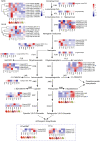Identification of key genes responsible for green and white colored spathes in Anthurium andraeanum (Hort.)
- PMID: 37745994
- PMCID: PMC10511891
- DOI: 10.3389/fpls.2023.1208226
Identification of key genes responsible for green and white colored spathes in Anthurium andraeanum (Hort.)
Abstract
Modern anthuriums, Anthurium andraeanum (Hort.) are among the most popular flowering plants and widely used for interior decoration. Their popularity is largely attributed to the exotic spathes with different colors. Previous studies have reported color development in red spathe cultivars, but limited information is available on key genes regulating white and green colored spathes. This study analyzed anthocyanin, chlorophyll, and carotenoid contents as well as transcript differences in spathes of eight cultivars that differed in spathe colors ranging from red to white and green. Results showed that increased expression of a transcription factor AaMYB2 was associated with elevated levels of anthocyanin in spathes, but decreased expression of AaMYB2 and increased expression of AaLAR (leucoanthocyanidin reductase) and AaANR (anthocyanidin reductase) were accompanied with the accumulation of colorless proanthocyanidin, thus the white spathe. As to the green colored spathe, chlorophyll content in the green spathe cultivar was substantially higher than the other cultivars. Correspondingly, transcripts of chlorophyll biosynthesis-related genes AaHemB (porphobilinogen synthase) and AaPor (protochlorophyllide oxidoreductase) were highly upregulated but almost undetectable in white and red spathes. The increased expression of AaHemB and AaPor was correlated with the expression of transcription factor AaMYB124. Subsequently, qRT-PCR analysis confirmed their expression levels in nine additional cultivars with red, white, and green spathes. A working model for the formation of white and green spathes was proposed. White colored spathes are likely due to the decreased expression of AaMYB2 which results in increased expression of AaLAR and AaANR, and the green spathes are attributed to AaMYB124 enhanced expression of AaHemB and AaPor. Further research is warranted to test this working model.
Keywords: Anthurium andraeanum; MYB transcription factor; anthocyanin; chlorophyll; flavonoid; spathe color.
Copyright © 2023 Li, Tan, Yi, Yu, Xia, Zheng, Chen, Zhou, Zhang and Guo.
Conflict of interest statement
The authors declare that the research was conducted in the absence of any commercial or financial relationships that could be construed as a potential conflict of interest.
Figures






Similar articles
-
Isolation and characterization of a R2R3-MYB transcription factor gene related to anthocyanin biosynthesis in the spathes of Anthurium andraeanum (Hort.).Plant Cell Rep. 2016 Oct;35(10):2151-65. doi: 10.1007/s00299-016-2025-8. Epub 2016 Jul 16. Plant Cell Rep. 2016. PMID: 27424029
-
Integrated small RNA profiling and degradome analysis of Anthurium andraeanum cultivars with different-colored spathes.J Plant Res. 2022 Jul;135(4):609-626. doi: 10.1007/s10265-022-01394-9. Epub 2022 May 9. J Plant Res. 2022. PMID: 35534649
-
Comparative transcriptomic analysis reveals key components controlling spathe color in Anthurium andraeanum (Hort.).PLoS One. 2021 Dec 10;16(12):e0261364. doi: 10.1371/journal.pone.0261364. eCollection 2021. PLoS One. 2021. PMID: 34890418 Free PMC article.
-
AaMYB3 interacts with AabHLH1 to regulate proanthocyanidin accumulation in Anthurium andraeanum (Hort.)-another strategy to modulate pigmentation.Hortic Res. 2019 Jan 1;6:14. doi: 10.1038/s41438-018-0102-6. eCollection 2019. Hortic Res. 2019. PMID: 30603098 Free PMC article.
-
Cloning and functional analysis of transcription factor AaCMB1 on carotenoid accumulation in spathe of Anthurium andraeanum.Plant Signal Behav. 2025 Dec;20(1):2527961. doi: 10.1080/15592324.2025.2527961. Epub 2025 Jul 7. Plant Signal Behav. 2025. PMID: 40619897 Free PMC article.
Cited by
-
Advances in Bract Coloration: Diversity, Pigment Synthesis, and Regulatory Mechanisms in Ornamental Plants.Plants (Basel). 2025 Jul 13;14(14):2155. doi: 10.3390/plants14142155. Plants (Basel). 2025. PMID: 40733391 Free PMC article. Review.
-
Chromosome-level genome assembly and annotation of Anthurium amnicola.Sci Data. 2025 Apr 10;12(1):605. doi: 10.1038/s41597-025-04939-4. Sci Data. 2025. PMID: 40210919 Free PMC article.
References
-
- Akagi T., Ikegami A., Suzuki Y., Yoshida J., Yamada M., Sato A., et al. . (2009). Expression balances of structural genes in shikimate and flavonoid biosynthesis cause a difference in proanthocyanidin accumulation in persimmon (Diospyros kaki Thunb.) fruit. Planta 230, 899–915. doi: 10.1007/s00425-009-0991-6 - DOI - PubMed
-
- Anthura B. V. (2002). Cultivation Guide Anthurium Pot Plant Culture Vol. 140 (Bleiswijk: Anthura; ).
-
- Baudry A., Caboche M., Lepiniec L. (2006). TT8 controls its own expression in a feedback regulation involving TTG1 and homologous MYB and BHLH factors, allowing a strong and cell-specific accumulation of flavonoids in Arabidopsis thaliana . Plant J. 46, 768–779. doi: 10.1111/j.1365-313X.2006.02733.x - DOI - PubMed
LinkOut - more resources
Full Text Sources
Research Materials

